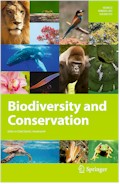| Journal Article |
 |
|
| Article Title | Plant functional types and traits as biodiversity indicators for tropical forests: two biogeographically separated case studies including birds, mammals and termites | | Author | Andrew N. Gillison, David E. Bignell, Kenneth R. W. Brewer, Erick C. M. Fernandes, David T. Jones, Douglas Sheil, Peter H. May, Allan D. Watt, Reginaldo Constantino, Eduardo G. Couto, Kurniatun Hairiah, Paul Jepson, Agus P. Kartono, Ibnu Maryanto, Germano G. Neto, Meine van Noordwijk, Elton A. Silveira, Francis-Xavier Susilo, Stephen A. Vosti and Paulo C. Nunes | | Year | 2013 | | Journal Title | Biodiversity and Conservation | | Institution | Springer | | Pages | 1-22 | | Call Number | JA0487-13 | | Keywords | Biodiversity indicators, Tropical fores, Plant functional typs, Habitat
characterization, Rapid biodiversity assessmen, Fauna |
|
| Abstract: |
| Multi-taxon surveys were conducted in species-rich, lowland palaeotropical
and neotropical forested landscapes in Sumatra, Indonesia and Mato Grosso, Brazil.
Gradient-directed transects (gradsects) were sampled across a range of forested land use
mosaics, using a uniform protocol to simultaneously record vegetation (vascular plant species, plant functional types (PFTs) and vegetation structure), vertebrates (birds, mammals)
and invertebrates (termites), in addition to measuring site and soil properties,
including carbon stocks. At both sites similar correlations were detected between major
components of structure (mean canopy height, woody basal area and litter depth) and the
diversities of plant species and PFTs. A plant species to PFT ratio [spp.:PFTs] was the best
overall predictor of animal diversity, especially termite species richness in Sumatra. To a
notable extent vegetation structure also correlated with animal diversity. These surrogates
demonstrate generic links between habitat structural elements, carbon stocks and biodiversity.
They may also offer practical low-cost indicators for rapid assessment in tropical
forest landscapes. |
|